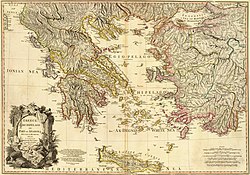
Back ملطية (مدينة إغريقية) Arabic Milet Azerbaijani Мілет Byelorussian Милет Bulgarian মিলেটাস Bengali/Bangla Miletos Breton Milet Catalan میلیتۆس CKB Milét Czech Miletus Welsh
Μῑ́λητος Milet | |
 | |
| Location | Balat, Didim, Aydın Province, Turkey |
|---|---|
| Region | Aegean Region |
| Coordinates | 37°31′49″N 27°16′42″E / 37.53028°N 27.27833°E |
| Type | Settlement |
| Area | 90 ha (220 acres) |
| History | |
| Builder | Minoans (later Mycenaeans) and then Ionians (the later on a former Anatolian site)[1][2][3] |
| Site notes | |
| Public access | Yes |
| Website | Miletus Archaeological Site |
| History of Greece |
|---|
 |
|
|
Miletus (Ancient Greek: Μίλητος, Mílētos) was an influential ancient Greek city on the western coast of Anatolia, near the mouth of the Maeander River in present day Turkey. Renowned in antiquity for its wealth, maritime power, and extensive network of colonies, Miletus was a major center of trade, culture, and innovation from the Bronze Age through the Roman period. The city played a foundational role in the development of early Greek philosophy and science, serving as the home of the Milesian school with thinkers such as Thales, Anaximander, and Anaximenes.
Miletus's prosperity was closely linked to its strategic coastal location and the productivity of its surrounding rural hinterland, which supported thriving agriculture and facilitated wide-ranging commercial activity. The city established dozens of colonies around the Mediterranean and Black Sea, significantly shaping the Greek world’s expansion.
Archaeological investigations have revealed a rich material culture, including the sanctuary of Apollo at Didyma, remnants of the city's distinctive grid plan, and evidence of long-term agricultural and rural management. Throughout its history, Miletus experienced periods of autonomy and foreign rule, serving as a cultural crossroads between Greek, Anatolian, and later Persian and Roman spheres. The city’s enduring legacy is reflected in its contributions to philosophy, urban planning, and the spread of Greek civilization.
- ^ Alice Mouton; Ian Rutherford; Ilya Yakubovich (7 June 2013). Luwian Identities: Culture, Language and Religion Between Anatolia and the Aegean. BRILL. pp. 435–. ISBN 978-90-04-25341-4.
- ^ Alan M. Greaves (25 April 2002). Miletos: A History. Taylor & Francis. pp. 71–. ISBN 978-0-203-99393-4.
The political history of Miletos/Millawanda, as it can be reconstructed from limited sources, shows that despite having a material culture dominated by Aegean influences it was more often associated with Anatolian powers such as Arzawa and the Hittites than it was with the presumed Aegean power of Ahhijawa
- ^ Sharon R. Steadman; Gregory McMahon; John Gregory McMahon (15 September 2011). The Oxford Handbook of Ancient Anatolia: (10,000-323 BCE). Oxford University Press. p. 369 and 608. ISBN 978-0-19-537614-2.
They had certainly been familiar with the territory earlier, in the Late Bronze Age, by way of commercial and political interests, and perhaps even trading posts, but now they came to stay. In the case of such settlements as Miletus and Ephesus, as implied, the Greeks chose the sites of former Anatolian cities of prominence.
